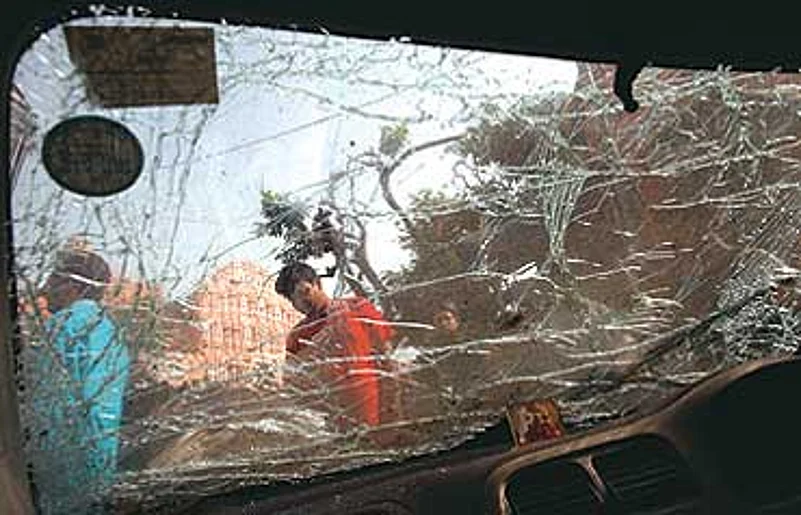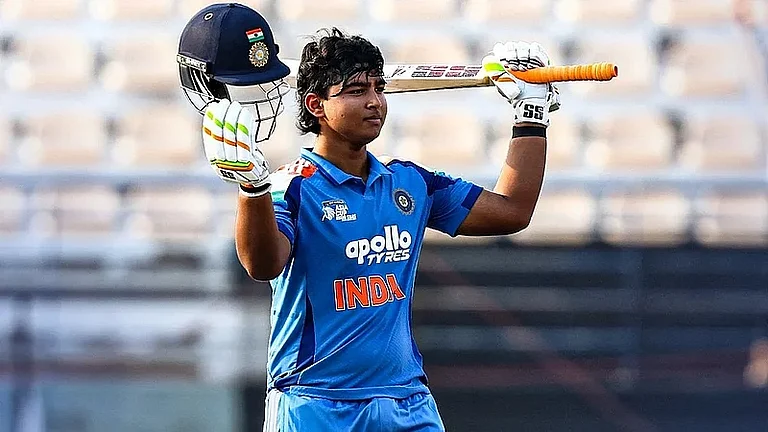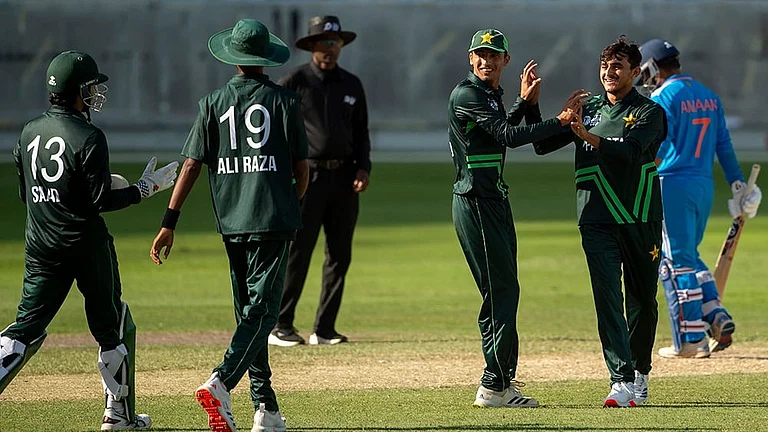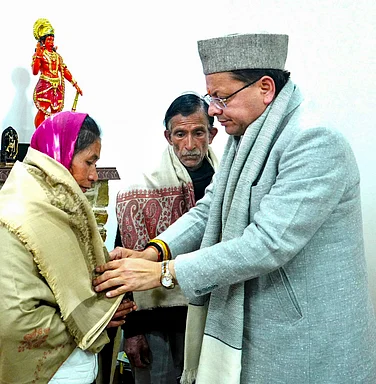
Most of the victims of the attack were the poor. And though two bombs exploded outside Hanuman mandirs, no single community was targeted. If the injured included 22-year-old Surendra Kumar Sharma who had travelled from Dausa for a job interview, there was also Muslim girl Suhana who had gone shopping for swimwear with her mother and two aunts but now remains among them the sole survivor of the blasts.
However, even as Jaipur struggled to come to grips with this wanton violence in its midst, the investigating machinery got cracking on identifying the possible suspects behind the blasts. Intelligence Bureau officials, explosives experts from the National Security Guards and officers of the Uttar Pradesh anti-terrorist squad descended on Jaipur the morning after the strike. The city police had already begun initial investigation the previous evening and set up a special team, headed by the Inspector General of Police, Laxman Meena.
The Bangladesh-based Harkat-ul-Jehad-e-Islami (HuJI) and its leader Mohammed Amjad also known as 'Khaja' emerged the first suspects. Khaja is believed to be of Bangladeshi origin and served as a deputy to Shahid Bilal who was killed under mysterious circumstances in Karachi last year. Bilal, originally from Hyderabad, had emerged as the new face of terror before he died. Khaja is believed to have taken over HuJI from him. Intelligence agencies suspect that the Jaipur blasts were scripted by him.
HuJI's hand in the chain blasts seemed confirmed when the police began tracing the 10 cycles that were used in the operation. They were found to have been bought from five shops in the city, including one from Shanti Trading Company. Its owner told the police that one of the persons who bought the cycles from him had a pronounced Bengali accent. That sort of nailed HuJI's role in the blasts for the police. Then came the twist in the tale.
An unknown outfit calling itself the Indian Mujahideen (IM) e-mailed a video footage of a blue satchel strapped to a cycle and claimed it was one of the vehicles used in the attack. Claiming responsibility for the blasts, the IM said it was conducting an "open war against India" and accused "moderate Muslims" of being "cowards". Sent from the e-mail id guru_al_hindi_jaipur@yahoo.co.uk, the police have traced the cyber cafe it was sent from in Sahibabad and have taken its owner Siyaram Mishra and his son Madhukar Mishra for questioning. However, not having heard of it before, investigators say they will first have to verify if it exists at all before proceeding on the investigation.
Like investigations in other blast cases, this one too will take time. Police officers are not confident of making any immediate headway. Talking to the cycle shop owners, they do suspect that there were at least 10 of them involved in the operation. "At least 10 people were involved in the attack since they went in teams of two to purchase the cycles," an investigator told Outlook. In a related development, the Rajasthan police claimed that six of the bombers came to the city from Varanasi by train. The police has also released a sketch of one of the suspects based on the statements of the cycle shop owners. However, investigators doubt that the suspects would still be around. In fact, they may have left the city much before the blasts. Early clues suggest that the terrorists may have placed the cycle bombs at various sites between 2.30 pm and 4 pm. This would have given them a sufficient lead of at least three to five hours to leave the city.

Shattered lives: A grieving family at the cremation grounds
Still, there is one vital piece of evidence that the terrorists unwittingly left behind—a tenth bomb that did not explode at the Hanuman Mandir near Chandpole. While the other nine were timed to detonate between 7.35 pm and 7.50 pm, the 10th was meant to go off at 8.35 pm. This, investigators now feel, was a mistake the terrorists made. Defused well in time, this bomb could well prove to be the key in the further investigation of the May 13 blasts.
Investigators have also discerned similarities between the bombs triggered in Jaipur and those detonated at the Lumbini Park and Gokul Chaat Bhandar in Hyderabad on August 26, 2007. The Jaipur ones, though, were different in design. They comprised a wooden base "shaped like an upturned boat" in which the explosive mix containing ammonium nitrate was placed. Contrary to initial reports, the forensic laboratory has not detected any RDX yet. The explosive-packed base was then wrapped tightly in a plastic sheet and placed in a small plastic container filled with metal splinters and ball bearings. The improvised explosive device (IED) thus prepared, it was put in a satchel, along with a timer and a detonator, and latched on to newly-purchased cycles.
However, even if the pattern of execution appears familiar, why it chose to play out in Jaipur remains a mystery. Pankaj Kumar Singh, IG, Jaipur range, thinks it is because Jaipur "is a soft target and terrorism has never figured in these parts". Intelligence intercepts, Singh goes on to say, always pointed to the fact that terrorists saw the city as a safe haven, not as a target. "They have possibly struck at tourism which is a mainstay of the economy here." The attacks, he adds, show how "terrorism has spread into the hinterland."
Indeed, its position as a major international tourist destination is being seen as a primary reason for Jaipur to have come in sight of a terror strike. The state attracts 12-14 lakh foreign tourists annually and even a hint of vulnerability to terror is sure to affect the tourism trade. Tuesday's attack may have already done the needful, with the US and Australian embassies being quick to caution their nationals on the dangers of travelling in India in general. Hotels too, across Rajasthan and in Jaipur in particular, have reported cancellation of advance bookings. And though the tourist season is over, the attack is most likely to impact the Rs 1,000-crore industry.

| Why us? An injured man breaks down before his father’s pyre |
By targeting Jaipur, the terrorists have also advertised the fact that they can strike at will, and anywhere. Their attack on the Rajasthan capital is also being seen as a warning to New Delhi, just 250 km away. The attack also has the potential of raising the communal temperature, in a state which hasn't seen any major riots. Already, political parties have begun to politicise the issue, with the BJP blaming the central government for a major intelligence failure and being soft on terrorism. The UPA, in turn, has been critical of the BJP-ruled Rajasthan government.
In New Delhi, the Union home ministry's assessment of the situation threw up the same old devil: the intelligence agencies had failed yet again. Gujarat chief minister Narendra Modi made the most of the situation, rubbishing central intelligence inputs and describing them as being "as vague as the weather reports". With the heat on once again on intelligence lapses, National Security Advisor M.K. Narayanan, say sources, has called for an emergency meeting with all intelligence and security heads. The NSA has now ordered that a special IB team be set up to liaise with the Jaipur police on a daily basis.
It's terrorists versus intelligence agencies again. And unless the latter think faster than the terrorists, cities like Jaipur will continue to be caught unawares.


























